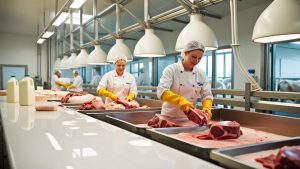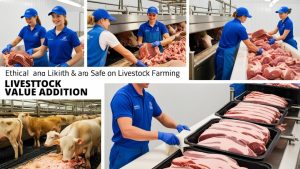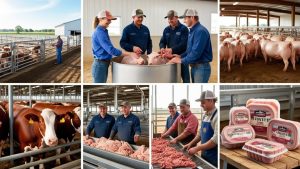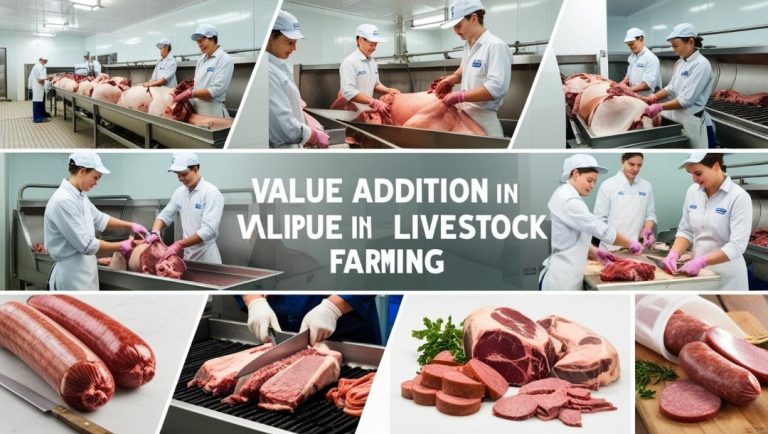Livestock farming is a crucial sector in agriculture, providing meat, milk, eggs, and other animal-derived products. However, the raw form of these products often has a limited shelf life, and their market value can be significantly enhanced through processing and value addition. These processes not only improve the quality, safety, and durability of livestock products but also open up new market opportunities and increase profitability for farmers.
This article explores the various aspects of processing and value addition in livestock farming, including methods, benefits, challenges, and economic impact.
Click HERE to join our WhatsApp group chat
Importance of Processing and Value Addition

a) Enhancing Product Shelf Life
Processing methods like freezing, drying, and canning help extend the storage duration of meat, milk, and eggs.
Value addition through preservation techniques reduces spoilage and food waste.
b) Improving Food Safety and Quality
Proper processing ensures the elimination of harmful pathogens, reducing the risk of foodborne illnesses.
Standardized production practices improve the overall quality and hygiene of livestock products.
c) Increasing Market Value and Demand
Value-added products such as cheese, yogurt, and smoked meat attract a wider consumer base.
Branding and packaging improve product appeal and consumer trust.
d) Boosting Farmer Income and Employment
Farmers can earn more by selling processed products rather than raw materials.
The livestock processing industry creates job opportunities in rural and urban areas.
READ ALSO: Duck Farming for Meat and Egg Production: A Comprehensive Guide
Processing of Livestock Products
a) Meat Processing
i) Slaughtering and Carcass Processing
Animals are slaughtered in hygienic abattoirs to ensure food safety.
Carcass dressing, cutting, and grading determine meat quality and market classification.
ii) Meat Preservation Techniques
Chilling and Freezing: Used to maintain freshness and prevent microbial growth.
Curing and Smoking: Enhances flavor and extends shelf life.
Canning: Creates ready-to-eat meat products with long-term storage potential.
iii) Value-Added Meat Products
Processed Meats: Sausages, ham, bacon, and meatballs.
Marinated and Pre-Cooked Meats: Ready-to-cook options for convenience.
Meat Jerky: Dried meat with enhanced flavor and preservation.
b) Dairy Processing
i) Pasteurization
Heating milk to kill harmful bacteria while preserving nutrients.
Essential for extending the shelf life of fresh dairy products.
ii) Cheese and Yogurt Production
Cheese: Fermented and aged dairy product with various textures and flavors.
Yogurt: Fermented milk product rich in probiotics and widely consumed worldwide.
iii) Butter and Ghee Production
Butter is made by churning cream, while ghee is clarified butter with a longer shelf life.
These products have higher market value and diverse culinary applications.
iv) Ice Cream and Flavored Milk
Value-added dairy products that cater to diverse consumer preferences.
Flavored milk offers variations like chocolate, vanilla, and fruit-based beverages.
READ ALSO: Energy Sources in Poultry Diets
c) Egg Processing
i) Pasteurized Liquid Eggs
Used in bakeries and food industries to prevent contamination risks.
ii) Powdered Eggs
Dehydrated eggs with extended shelf life and ease of transportation.
iii) Specialty Eggs
Fortified eggs with omega-3, selenium, or other nutrients.
Pickled eggs and century eggs as traditional delicacies.
d) Leather and Hide Processing
Animal skins are processed into leather for clothing, footwear, and upholstery.
Value addition includes tanning, dyeing, and finishing for high-end fashion products.
e) Wool and Fiber Processing
Wool from sheep and goats is cleaned, spun, and woven into textiles.
Specialty fibers such as alpaca and cashmere undergo premium processing.
f) Bone and By-Product Utilization
Animal bones are processed into gelatin, bone meal, and pet food ingredients.
Blood meal and fish meal are used in livestock feed formulations.
READ ALSO: Common Health Challenges in Guinea Fowl
Economic and Market Benefits of Value Addition

a) Increased Profit Margins
Farmers earn more by selling processed goods rather than raw materials.
Higher-end products like organic cheese and premium meat cuts generate better revenue.
b) Expansion of Market Access
Processed livestock products have access to international markets.
Proper packaging and certification improve product competitiveness.
c) Creation of Agribusiness Opportunities
Small-scale farmers can venture into meat processing, dairy processing, and egg value addition.
Local enterprises benefit from increased employment in food processing industries.
Challenges in Processing and Value Addition
a) High Initial Investment Costs
Equipment and processing facilities require significant capital investment.
Farmers may need government or private sector support to establish processing units.
b) Regulatory and Quality Standards
Strict food safety and hygiene regulations must be met.
Compliance with labeling, storage, and transportation laws is essential.
c) Market Competition and Consumer Preferences
Processed livestock products must compete with established brands.
Understanding consumer preferences and trends is crucial for success.
d) Limited Access to Processing Technology
Small-scale farmers may lack modern processing equipment.
Training and capacity-building programs are necessary to bridge the knowledge gap.
READ ALSO: Ethical Considerations in Livestock and Poultry Farming
Strategies to Improve Processing and Value Addition

a) Adoption of Modern Processing Technologies
Investment in automated processing systems to enhance efficiency.
Cold storage and vacuum-sealing techniques to preserve product quality.
b) Strengthening Farmer Cooperatives and Agribusiness Models
Cooperatives can facilitate collective investment in processing facilities.
Partnerships with private sector companies to support value addition initiatives.
c) Government Support and Policy Development
Subsidies and grants for livestock farmers to establish processing units.
Strengthening food safety and certification programs.
d) Consumer Education and Market Awareness
Promoting the benefits of value-added livestock products.
Branding and marketing strategies to attract a larger consumer base.
Conclusion
Processing and value addition in livestock farming play a critical role in enhancing product quality, safety, and profitability. By investing in processing technologies, maintaining high hygiene standards, and exploring market opportunities, livestock farmers can maximize returns and contribute to the global food supply chain. While challenges exist, strategic investments and policy support can help overcome barriers, ensuring sustainable growth in the livestock value-added sector.
READ ALSO: Essential Proteins for Turkey Growth
Proteins are fundamental nutrients required for the proper growth, development, and overall health of turkeys. They play a crucial role in muscle formation, immune function, and metabolism. In commercial turkey farming, ensuring an optimal protein intake is essential for maximizing meat production, improving feed efficiency, and achieving fast growth rates…
READ ALSO: Nutritional Needs for Guinea Fowls
Proper nutrition is crucial for the optimal growth, reproduction, and overall health of guinea fowls. These hardy birds have unique dietary requirements that differ slightly from chickens, requiring higher protein intake and a balanced mix of essential nutrients for egg production, meat quality, and disease resistance. Understanding their nutritional needs at different life stages ensures maximum productivity and profitability in guinea fowl farming…
Click HERE to join our WhatsApp group chat

